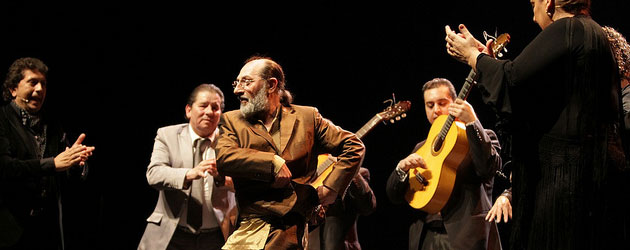Text: Estela Zatania
Photos: JeanLouis Duzert
Friday,January 18th, 2013. 8:00pm Teatro de Nimes (France)
WHEN COMPÁS IS DESTINY AND DESTINATION
Boboterías. Cante: Mari Vizárraga, El Vareta, Guillermo Manzano. Guitar: Ramón Amador, Paco Iglesias, Emilio “Caracafé”. Dance and palmas: Torombo, Pepe Torres, Bobote, Eléctrico.
Last night at the theater of Nimes some locals, upon seeing me with a notebook and no doubt an aloof look on my face, asked me if “boboterías” was the name of a flamenco form, like alegrías or siguiriyas. And for a brief moment I was tempted to say it was, because in a certain sense it feels like another dimension of flamenco. The one that used to be the only dimension and now making a comeback as novelty: that of good solid singing, dancing and guitar, that of compás and emotion.
The house was sold out, and there was a great deal of expectation – the people of Nimes know exactly what they like. The same breath of flamenco energy that relieved the intense summer heat that night four months ago at the last Bienal de Sevilla, gusted through Nimes to warm up the freezing cold we’re fending off in the street. A select group of extraordinary artists practically unknown to audiences (please consult the roster of names above) came together to do the same thing they’ve been doing all their lives, while granting us the privilege of observing the results. And Bobote, the one who does the least and represents the most, the compact man who is the driving force and inspiration for all the rest. When the flamencos of Triana were sent packing to the housing project known as Las Tres Mil Viviendas, most of the baggage their took with them was intangible: their art and their culture.
The show opens with a brief film that performers and audience watch closely, and in which we see that familiar dance bit of José Jiménez, Bobote as a child some forty years ago, and which he will repeat again this night with the same spark as then. Eléctrico, Torombo and Pepe Torres answer with their own little dances, what can I possibly say to those of you who already knew these men! Oddly enough, many French fans have only see women flamenco dancers, and these masculine forms so typical of Triana left them, quite frankly, agape. The outstretched arms, the intensity, the brutal elegance and total commitment triggered excited cheering when the evening had only just begun.
For the rest of the show, each individual did their particular bit up front, just as in traditional gatherings. Vareta sang martinete and soleá with his fascinating thick voice. Tangos, from Triana of course, and it’s pure energy anchored to earth, everything nourishes and stimulates. Guillermo Manzano sang soleá with a voice and delivery half-way between Antonio Mairena and Pansequito, quite a feat in itself – this is another singer worthy of attention.
Mari Vizárraga, the only female member of the group, sang alegrías for Pepe Torres who recreated the wonderful dancing of his family, that of Pepe Ríos and Andorrano. And at this point you don’t know what’s “fresh”, “pure”, “old” or “new”, because what’s truly worthwhile is timeless and defies definitions.
Guitar solos of the picturesque Caracafé, quoting melodies of Camarón, reflect the dawn of the Paco age.
Vareta again por soleá, Torombo stands up and the atmosphere feels dense…that “tense calm” reporters always refer to in dramatic situations…and Torombo does not disappoint anyone.
This time the bulerías fiesta finale is neither contrived nor forced, but rather the natural destiny of this collection of artists, the last and youngest generation of real-life flamenco.
And thus ended that which will never end, the heartbeat of compás as it is understood in Seville, its neighborhoods and the people who live there.
At half past ten, we went to a new venue, the Paloma Club, where Tomás Moreno, “Tomasito”, well-known and loved in Nimes, gave a recital of his most pop-rock-oriented repertoire in a performance backed up by his group, Francisco José Vidal on flamenco guitar, José Atero electri guitar, Gaspar Fernández on drums and Jesús Hidalgo on the upright bass.
Video Boboterías – Bienal de Sevilla
